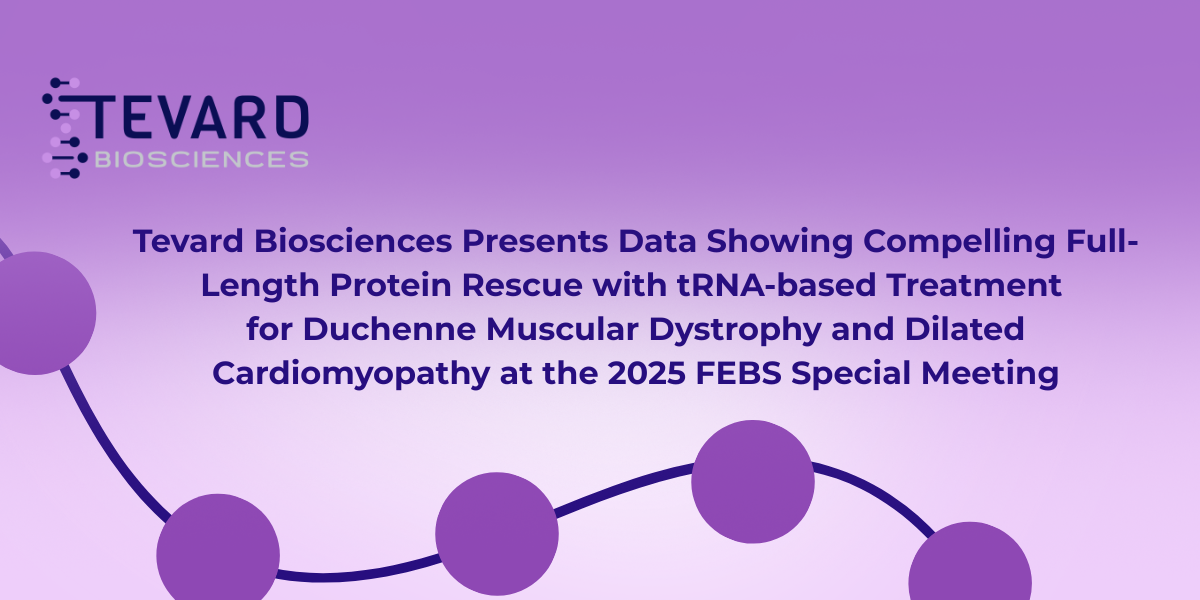Tevard Biosciences Demonstrates Promising Protein Restoration in Duchenne Muscular Dystrophy and Heart Disease Models

Summary
Full Article
Tevard Biosciences, Inc. presented new preclinical data demonstrating potent restoration of full-length functional proteins in models of Duchenne muscular dystrophy and dilated cardiomyopathy caused by titin truncations. The findings, presented at the 2025 Federation of European Biochemical Societies Special Meeting in Dubrovnik, Croatia, showed on average 70% restoration of wild-type dystrophin protein in DMD models using the latest generation of suppressor tRNAs, supporting potential for meaningful clinical outcomes at lower doses.
Elisabeth Gardiner, PhD, Chief Scientific Officer of Tevard Biosciences, delivered the invited oral presentation and poster session titled "The Use of Therapeutic Suppressor tRNAs for the Treatment of Duchenne Muscular Dystrophy and Dilated Cardiomyopathy." Dr. Gardiner emphasized that the engineered suppressor tRNAs restore full-length, native protein expression at levels that are both biologically meaningful and clinically promising. The platform leverages native cellular machinery to produce natural proteins that function as the body expects, which is particularly crucial for structural proteins like dystrophin and titin where proper folding, localization, and protein-protein interactions are essential.
In the Duchenne muscular dystrophy program, AAV-delivered suppressor tRNAs targeting Gln-TAA and Arg-TGA nonsense mutations restored on average 70% of full-length wild-type dystrophin levels in vivo, with strong correlation to motor function recovery and normalization of proteomic biomarkers. The dilated cardiomyopathy program showed equally compelling results, with suppressor tRNA treatment restoring full-length titin protein expression and contractility in iPSC-derived human cardiomyocytes within four days. In vivo studies demonstrated that AAV-delivered Arg-TGA suppressor tRNAs drove robust full-length titin production and restored proteomic homeostasis in the heart within six weeks in a TTNtv mouse model.
Both programs demonstrated dose-dependent transduction, protein rescue, and functional improvement following systemic administration, with no detectable toxicity or off-target effects. Notably, suppressor tRNA expression and protein rescue were sustained up to 12 weeks post-treatment, highlighting the durability of the therapeutic effect following a single intravenous dose. These data represent the first public disclosure of results from Tevard's DCM-TTNtv program, one of its lead development efforts, further demonstrating the versatility and maturity of its suppressor tRNA platform across genetically distinct indications.
Daniel Fischer, Co-Founder, President and CEO of Tevard Biosciences, noted that being selected for a featured presentation at the world-class conference highlights the impact of their suppressor tRNA platform. Recent breakthroughs in suppressor tRNA and vector design have achieved the protein rescue levels needed to confidently advance both the DMD and DCM-TTNtv programs into clinical development at safe, efficacious doses. The company's platform has evolved from Gen 1 molecules with a single anticodon edit to Gen 3 candidates optimized through high-throughput screening of over 80,000 variants.
These rationally engineered suppressor tRNAs achieve efficient and codon-specific readthrough of the most common premature stop codons (UGA, UAA, UAG) that underlie 10–40% of all genetic diseases. The development of suppressor tRNAs with highly efficient readthrough of premature termination codons positions newer lead candidates to restore substantial wild-type protein levels in preclinical models. Both the DMD and DCM programs are advancing toward development candidate nomination in Q1 2026, potentially offering new therapeutic options for patients with these devastating genetic conditions. For more information about Tevard Biosciences and their innovative approach to genetic disease treatment, visit https://www.tevard.com.

This story is based on an article that was registered on the blockchain. The original source content used for this article is located at Reportable
Article Control ID: 237041